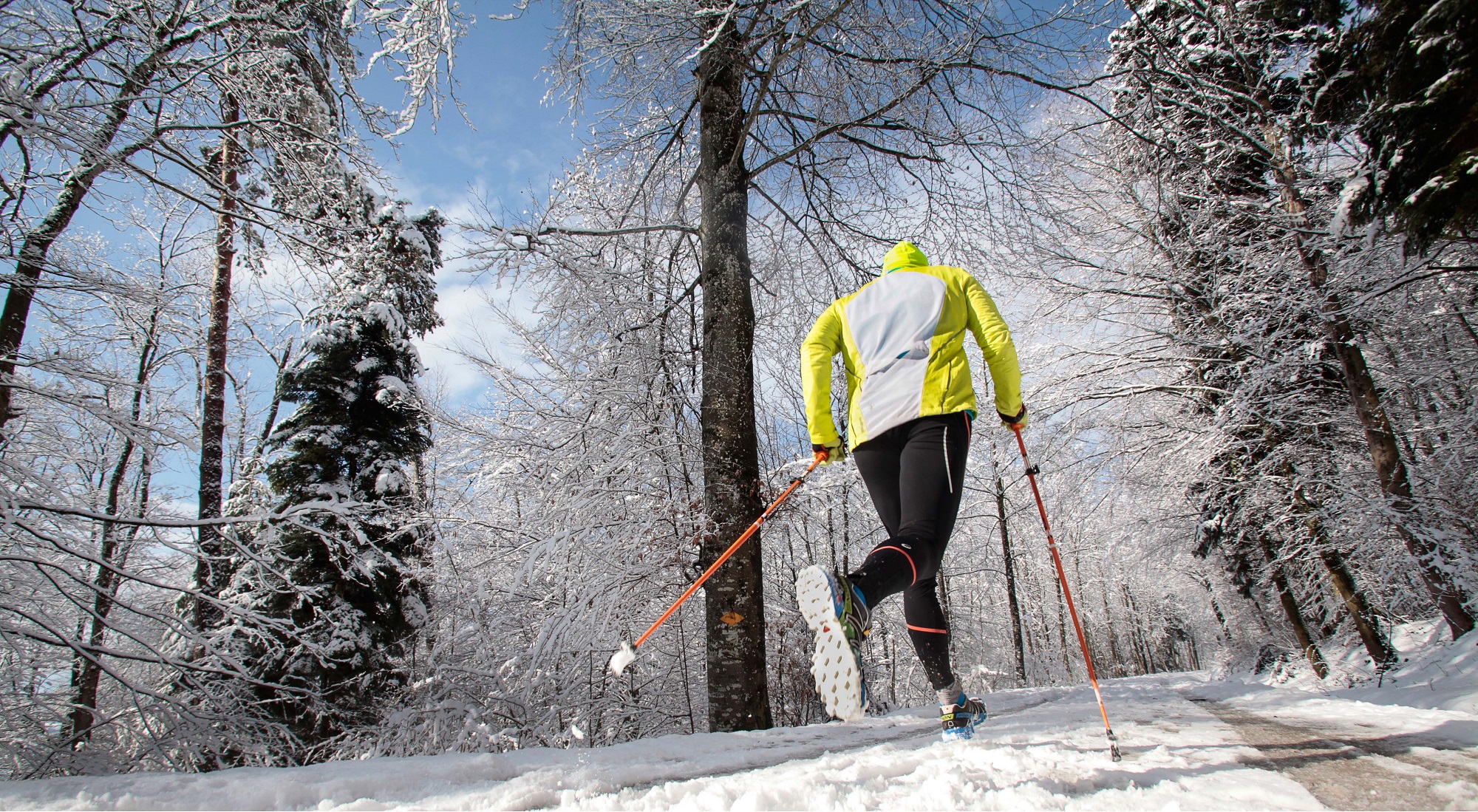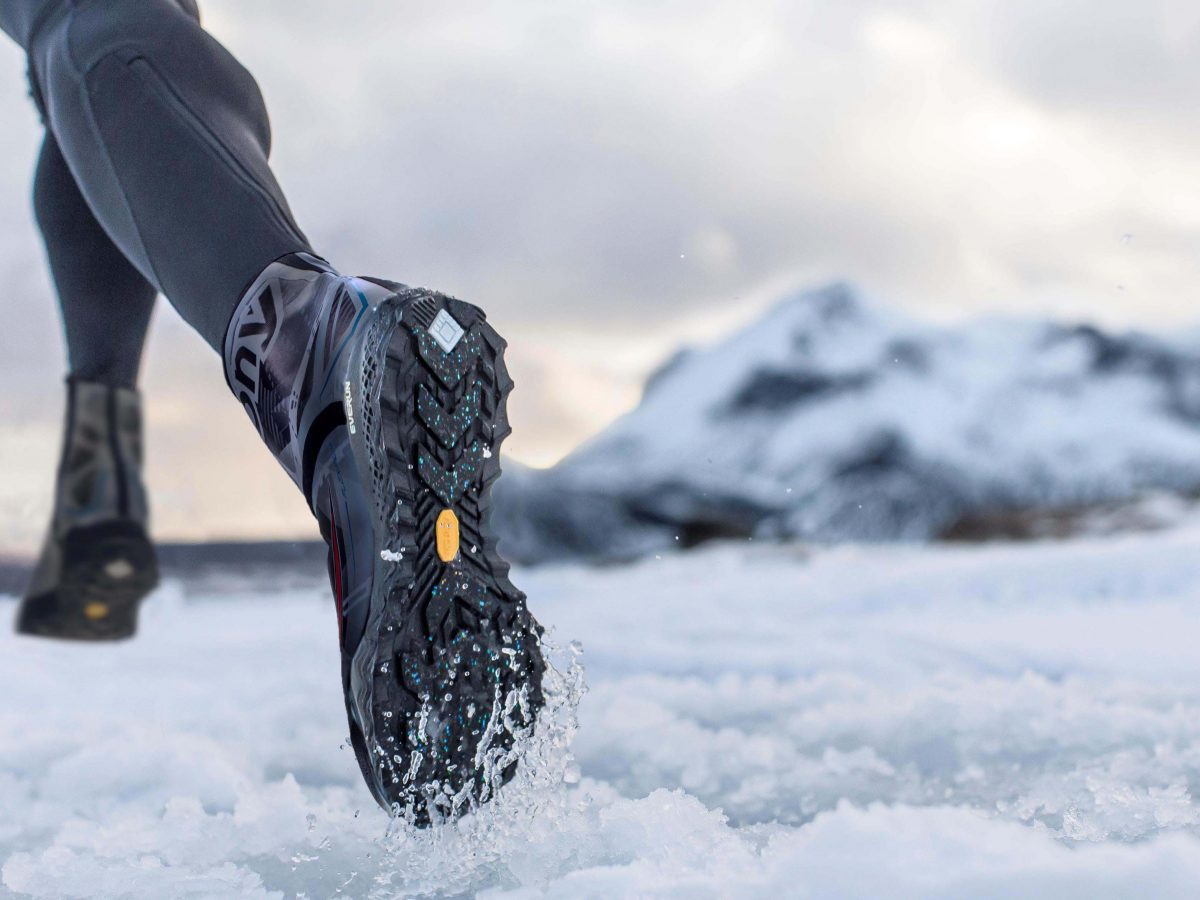Running has long become a sport for all seasons, including winter. Many people even find running in the snow especially appealing. But caution! Training on snow poses some challenges to our locomotor system, which need to be handled right. Here the best tips.
You can see your own breath in front of your eyes, your cheeks prickle from humidity and coldness, the foamy powder snow scrunches below your feet at each step. The branches of the trees lean to the side threateningly at the weight of the snow. Even though you might have taken a lot of convition to get out for run, the feeling of pleasant exhaustion and happiness you get in a hot shower after a run out in the snow is definitely worth it.
Also in terms of health, nothing stands in the way for a run in the snow – on the contrary. Today, there are suitable shoes for any running activity, including winter. Good soles with grip, good stability, a robust mantle, maybe even with a waterproof membrane – and cold and wet feet belong to the past. No wonder more and more people run through nature even during winter.

As positive as the trend of running towards being a sport for the whole year may be, it is still important to remember that you cannot compare running on snow to running on steady and smooth surfaces like asphalt, or with a snow-free forest road. Put simply, there are three possbile types of snowy grounds to run on.
Fresh powder snow
A run in fresh powder snow is the most adventurous and the most popular form. However, it is not always possible. Depending on the snowfall, the situation can change considerably within a short time and this also affects our running style. The ideal amount is a layer of about 5-10 cm of very fresh poder snow. That way, the snow works as a cushioning mechanism for us runners, rendering each of your steps light and easy, just like on a woodchip trail. You literally fly through the snow. It gets a little trickier with a thicker layer of powder snow. Due to the height of the layer, you must lift the forward section of your feet upwards in order not to get stuck in the snow, just like you took a hurdle. For each landing you have to try and find steady ground to put your feet on, so that you can put all your weight down properly. The running technique for this kind of condition can be described rather as some sort of skipping than as smooth, bouncy running.
Prepared winter hiking trail/road
Switzerland (as well as, probably, the country in which you live) offers a wide range of winter hiking trails, all of which are regularly prepared by machines, similarly to ski slopes. The conditions on those trails are thus relatively consistent, the snow always being compact and firm. In some cases, however, the machine has left a loose top layer. As a result, your feet sink into the loose snow a little bit with every step and each time you push away for the next step the snow does not give you enough support. A solution to this problem is to take more and smaller steps.

Hard-packed forest trail/road
If the snow settles and no additional snowfall occurs the days after, many field and forest roads either turn sludgy or hard and uneven – depending on the temperature. Running on this kind of ground can be compared to running on a single trail in the forest interveined by roots, posing a real challenge to your feet, your legs and your core. Your feet do not meet even ground, whereby they don’t have a steady position, but must be actively stabilised with each step. As a consequnce, the risk of slipping or twisting your ankle increases.

What you need to consider when running on snowy ground: The most important points
- Get used to it: One needs to get used to running on snowy ground. Thus, you should take it slowly and you should only do shorter sessions to start with. Don’t begin with a marathon distance on hard-packed snow, otherwise sore muscles are guaranteed (especielly in your ankles).
- Adapt your running technique: Running on soft snow requires work form your muscles which is very different from the one on asfalt. Since your feet sink into the snow, you need to work for getting a steady position and not slipping. Your contact with the ground is thus much longer than on steady ground. You are forced to lower your pace and to spread your arms a little to stabilise. This constant stabilising and working for a steady position means a greater effort for your muscles. Other consequences of an unsteady position: lower pace and smaller steps. Tipp: Nordic running, that is, running with poles, is a good option during winter. The poles can be a great help in balancing your body and, at the same time, you can train your arms.
- Experience first: A run in the snow should, above all, be considered an adventure, a variation and an exercise for your coordination. You should not be too fixed on specific distances, paces or intervals if you run on snow. If you are preparing for a marathon it is better to conduct your specific preparations for that on roads free from snow. If you are a runner with high ambitions, we recommend you to do around 70% of your training on steady ground.
- Avoid overloads: If the conditions of snowy ground persist for a long time, try not to run too often and not only on snow, since, otherwise, overloads and other injuries may soon be the result (adductors, hamstrings, plantar fascia, calves, Achilles tendon). A lot of ambitious runners get injuries from running on snowy and icy ground during winter. Be aware of the risks of slipping or of twisting your ankle. Thus, try to plan your important sessions on flat and snow-free ground, or indoors.
- Snow “makes you slow”: In order to train the muscles used for running, they need the percussions. Otherwise, they cannot build the so-called contractive elements needed for fast running with short soil contact or for very long runs. In other words: if you train on soft ground too often, you are not training right with respect to pure running capacity. Of course, you train your overall stamina. But in terms of running in specific, you will probably rather get slower than faster.
- Right choice of shoes: If you run a lot on snow, you should think about the choice of your shoes. Of course, the type of snow plays a role. Running on a prepared winter hiking trail/road requires different shoes than running in powder snow does. An important precondition for a steady postion of your steps on snow is a very direct shoe with a flat, thin sole (the heels not being supported a lot more than your toes) with a good profile and maybe even with spikes. Furthermore, the shoe should offer a good grip for your heel and it should have a robust mantle. Normally, trailrunning shoes are a good choice.
This blog entry by Andreas Gonseth was provided by Fit for Life. Fit for Life is a Swiss magazine for fitness, running and endurance sports. Are you interested in reading such articles regularly? Click here. (This magazine is available only in German)


